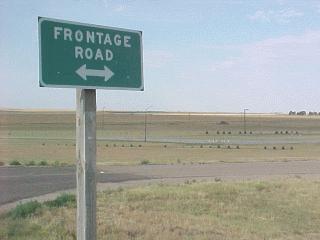A Texas shibboleth
One of the first things that astute visitors and new arrivals to Texas notice is the ubiquity of frontage roads along our freeways. Indeed, Texas has more frontage roads than any other place on the face of the planet. The reason for this phenomenon is because, unlike most other states, Texas frequently upgrades existing roadways to freeways instead of building them on entirely new right-of-way, especially in urban areas. For instance, most of I-35 through Texas was built along what used to be US 81. Because adjacent property owners already had access to the existing highway, the state would either have had to purchase those access rights when the road was upgraded (freeways are controlled-access), which in many cases might actually have resulted in a full-blown taking of the property, or they would have had to devise a way to maintain access to those properties. Texas chose the latter.
This also fit in well with the philosophy of Dewitt Greer, the commissioner of the Texas Highway Department at the time work on the Interstate Highway System in Texas was in full bloom. He wanted Interstates in Texas to serve not only long-distance traffic, but also local and regional traffic. To do so would require more frequent entrances and exits. Frontage roads helped fulfill that desire.
Note that on freeways that were built on entirely new right-of-way, frontage roads are often noticeably absent. Examples are long stretches of I-37 and I-10.
Sometime around 2002, the Texas Transportation Commission studied changing its longtime policy of building frontage roads and proposed instead to build “backage” roads, which would run along the backside of the properties that fronted a freeway. At public hearings around the state on the idea, including in San Antonio, people voiced general opposition to the idea, and it was subsequently scrapped.
One interesting aspect of frontage roads is that they’re known by different names around the state, making for a sort of Texas shibboleth. In Houston, they’re called “feeder roads” or just “feeders”. In the DFW Metroplex, they’re referred to as “service roads”. San Antonians call them “access roads”. Austin uses “frontage roads”, and that’s the state’s official term for them, which appears on TxDOT signs around the state regardless of the local nomenclature. Probably the most unique term is in El Paso, where they’re known as “gateways”.
In addition to being able to determine what part of the state a person hails from by what they call these roads, I’ve also found that you can measure the area of influence exerted by the state’s major cities by determining what term is used in the hinterlands. For instance, most of East Texas uses the term “feeder”, illustrating the dominance that Houston has on that part of the state. When “feeder” turns to “service road”, you know you’ve entered DFW country. San Marcos provides an even more interesting aspect. Today, San Marcos is clearly in Austin’s realm, but the frontage roads along I-35 are typically referred to as “access roads” by long-time locals. This reflects the fact that when I-35 was built in the ‘60s, San Antonio’s influence prevailed in San Marcos. As Austin has grown, however, that influence has been diluted. Still, the “access road” moniker has prevailed, although it will be interesting to see if it continues to survive in the future.
Related links:
